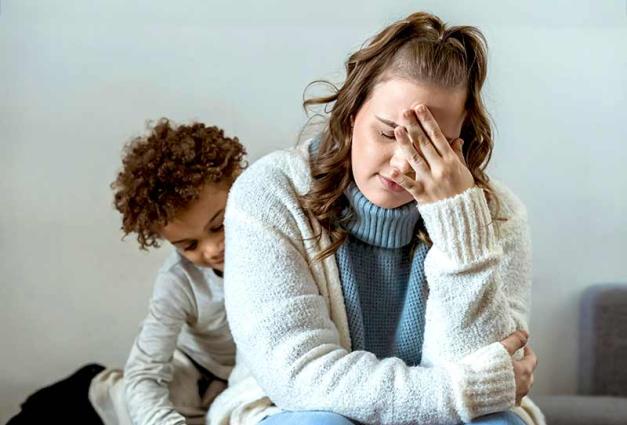Young adults are in a critical period in life. If everything goes well, young adults select into social networks, initiate friendships and romantic relationships, and find their occupational niche. In other words: Young adulthood is full of exploration. But what happens if young adults suddenly find themselves exposed to collective stressors that heavily limit their opportunities for exploration? Addressing this question was the main goal of the present study.
It's Not Easy to Study This Question
Studying the effects of collective stressors is not simple, because ideally one needs a group of people who are exposed to stressors and a comparison group of people who are not exposed to stressors. In times when the stressors affect nearly everyone, having a group that is not exposed to stressors is literally impossible. Our study design had the unique advantage of having both groups: We had a comparison group of young adults (average age of 20) who were surveyed eight times in 2019, before the COVID-19 pandemic, and a high-stress group of young adults of similar age who were surveyed eight times in 2020, during the first grueling year of the pandemic. Furthermore, it was not only the pandemic that created stress: the 2020 group experienced yet other stressors: extreme wildfires, social tensions associated with the murder of George Floyd, and a contentious election. So, this study allowed us to compare the groups in their trajectories of psychosocial development. We studied both their psychological functioning in terms of subjective well-being and their social functioning in terms of social support and relationship satisfaction.
Young Adults Are Affected by Collective Stressors
Our findings showed that collective stressors may set young adults on a less fortunate path. Specifically, young adults of the high-stress group had disrupted developments in their emotional well-being and social functioning, such as decreasing positive feelings and decreasing relationship satisfaction. In general, the effects tended to be small, but also small effects can have lasting implications, especially when they occur in a sensitive life period.
What Are the Reasons for the Disrupted Development?
In exploratory analyses, we aimed to identify potential reasons for the disrupted developments and looked at COVID-19-related concerns (such as behavior change through the pandemic). Interestingly, these concerns explained some of the trends, but not all. Hence, while it is true that the pandemic was a severe and ongoing stressor in 2020, it was not the only one, and it was not the single driving force. Rather, it tended to be the multitude of stressors in 2020 that contributed to the less fortunate development among young adults.
It is About the Multitude of Stressors
Environmental conditions are critical for development because they provide the opportunities that individuals need to grow in a healthy way. If numerous collective stressors are present, as was the case in 2020, the opportunities are limited in a number of ways. For example, the pandemic severely constrained face-to-face contact and physical intimacy among young adults, and this likely impacted their daily social lives and social experiences. Moreover, the severe wildfires in Northern California, where the study was done, had a major impact on young adults' social lives, because young adults could not leave their houses due to the smoke or had to leave their houses for personal safety. These limitations were especially drastic during the lockdown because the limited ways to be social during the lockdown (such as going for a walk) were further restricted by the wildfires. Finally, experiencing limiting opportunities and being confronted with both health concerns and political tensions likely created fear and alertness among young adults, which resulted in lower emotional well-being.
Young Adulthood is a Particularly Sensitive Life Period
People of all ages likely are affected by collective stressors, but young adults are particularly affected by these stressors, because their development heavily depends on the conditions and opportunities that are available. In contrast to other developmental periods in life, young adults are still on their way to finding their path in life. Therefore, this research raises awareness to monitor young adults' psychosocial development more closely in times of collective stressors, for instance through counseling programs in companies and universities.
Needless to say, not every young adult was equally affected by the collective stressors. This, in turn, suggests that there are certain protective factors that help young adults to cope well with the stressors—but also that there are also certain risk factors that make it even more difficult for young adults to cope. Protective factors could be a close social network and risk factors could be the personality trait of neuroticism, which increases the tendency to worry. We need future research to identify the protective and risk factors and to implement them in intervention studies with young adults.
For Further Reading
Bühler, J. L., Hopwood, C. J., Nissen, A. T., & Bleidorn, W. (2022). Collective stressors affect the psychosocial development of young adults. Social Psychological and Personality Science. https://doi.org/10.1177/19485506221119018
Overall, N. C., Chang, V. T., Pietromonaco, P. R., Low, R. S. T., & Henderson, A. M. E. (2022). Partners' attachment insecurity and stress predict poorer relationship functioning during COVID-19 quarantines. Social Psychological and Personality Science, 13(1), 285–298. https://doi.org/10.1177/1948550621992973
Romm, K. F., Park, Y. W., Hughes, J. L., & Gentzler, A. L. (2021). Risk and protective factors for changes in adolescent psychosocial adjustment during COVID‐19. Journal of Research on Adolescence, 31(3), 546–559. https://doi.org/10.1111/jora.12667
Janina Larissa Bühler is an Assistant Professor of Personality Psychology and Psychological Assessment at the Johannes Gutenberg University Mainz. She studies the ways in which people's personalities and their social relationships develop over time.




